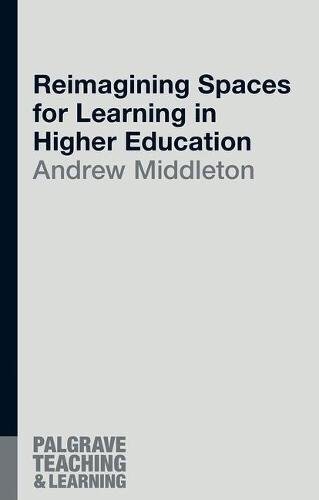As someone with a strong producer self-identity, I think crafting titles can be a useful way of capturing the essence of what you are trying to do and give you focus. This applies to books, articles, essays, student work, videos, songs, blog posts, photographs, paintings, performances… anything that involves a creative process.
A title is like the ultimate elevator pitch. It needs to grab attention and immediately explain what the artefact is about. I tend to do this in two parts – a catchy title followed by an explanatory subtitle.
The title of my new book has changed several times during its writing and bucks the two part method. Book proposal forms are quite prescriptive however: after all, publishers and their editors have much more experience of what works and I was particularly keen to listen to my series editor Professor Sally Brown. Brevity and clarity are characteristics of a good book title.

So, we went with Reimagining Spaces for Learning in Higher Education. This works very well for me. I’ll reflect on the word ‘reimagining’ in a minute, but I’ll start at the end.
Higher Education – this is what the series is about – teaching and learning in higher education. This was always key for me. One of my drivers was the complacency I have experienced over many years in HE about academic innovation. By and large, many teachers accept there are ways of going about things that really do not need to be discussed or which are beyond their powers to change or influence. Similarly, university managers and estates personnel often have remarkably weak understandings of the relationship between teaching and learning and the space we experience. As our understanding of pedagogy continues to develop, especially in relation to the integration of technology, this has become a significant barrier to teaching excellence. This book is very much about setting an agenda for disrupting complacency and inspiring innovation in higher education.
Spaces for learning – not learning spaces? Learning spaces is associated by many with the built environment and it is unhelpful to use this nomenclature. The book is about the built environment in part, but it is about much more. It is about how we, as users of spaces, have more agency than we often realise. It is about any space we deem to be learning space. For example, I emphasise non-formal learning space and ideas of place as being generally neglected in our thinking but important for learning nonetheless. Ultimately, our interest as educators is in the learning experience each student has and how this in affected by space as it is conceived, perceived and used.
Reimagining – I was advised, rightly, to use this. Rightly, because it recognises the role of the reader. The book includes 27 case studies of innovative practitioners who, in my opinion, have reimagined space and put that imagination into practice. In each case the experience covered in the study has been significant for them, though many of the innovations may be quite familiar. Nevertheless, these people have not only reimagined (constructed an alternative view), but enacted this. They have remade their situation. This idea of remaking is important to me and the book. There is a chapter looking at the academic innovator. What comes from this is the idea of agency – innovators take responsibility for their environment. So, ‘remaking’ was an important idea, but perhaps overly esoteric for a title. It needs some explaining. Reimagining, on the other hand, is something that I think everybody does continuously. It is part of a state of being critical and creative.
Conclusion
Time spent with a title is time well spent and the act of committing to a title is both manageable and critical. For creative assignments, from essays to performances, we may ask students to use a given title and analyse it, but perhaps we should appreciate the learning value of constructing titles for our work more often.
